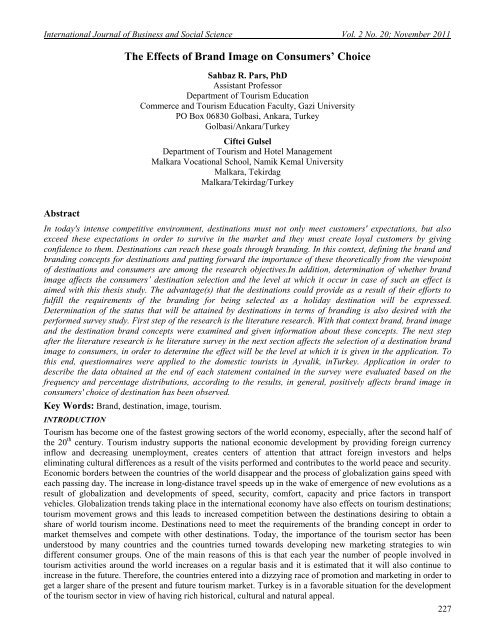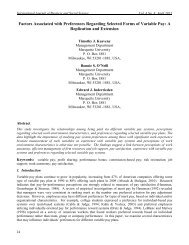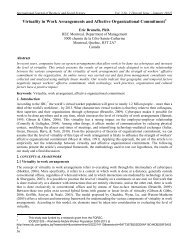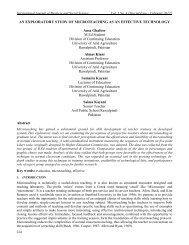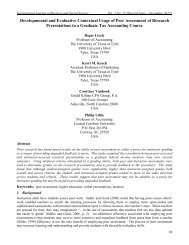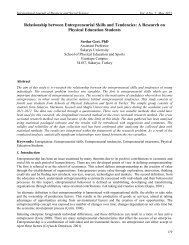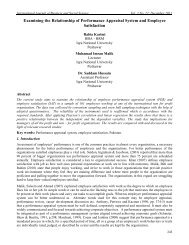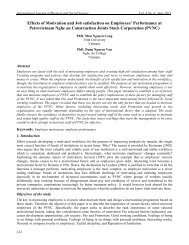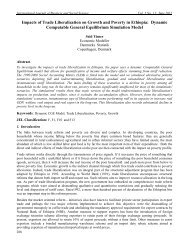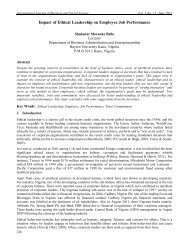xxxxxxxxxx xxxxxxxxxxxxx makalenin Türkçe baÅlıÄı xxx xxxxxxxxx ...
xxxxxxxxxx xxxxxxxxxxxxx makalenin Türkçe baÅlıÄı xxx xxxxxxxxx ...
xxxxxxxxxx xxxxxxxxxxxxx makalenin Türkçe baÅlıÄı xxx xxxxxxxxx ...
You also want an ePaper? Increase the reach of your titles
YUMPU automatically turns print PDFs into web optimized ePapers that Google loves.
International Journal of Business and Social Science Vol. 2 No. 20; November 2011<br />
The Effects of Brand Image on Consumers’ Choice<br />
Sahbaz R. Pars, PhD<br />
Assistant Professor<br />
Department of Tourism Education<br />
Commerce and Tourism Education Faculty, Gazi University<br />
PO Box 06830 Golbasi, Ankara, Turkey<br />
Golbasi/Ankara/Turkey<br />
Ciftci Gulsel<br />
Department of Tourism and Hotel Management<br />
Malkara Vocational School, Namik Kemal University<br />
Malkara, Tekirdag<br />
Malkara/Tekirdag/Turkey<br />
Abstract<br />
In today's intense competitive environment, destinations must not only meet customers' expectations, but also<br />
exceed these expectations in order to survive in the market and they must create loyal customers by giving<br />
confidence to them. Destinations can reach these goals through branding. In this context, defining the brand and<br />
branding concepts for destinations and putting forward the importance of these theoretically from the viewpoint<br />
of destinations and consumers are among the research objectives.In addition, determination of whether brand<br />
image affects the consumers’ destination selection and the level at which it occur in case of such an effect is<br />
aimed with this thesis study. The advantage(s) that the destinations could provide as a result of their efforts to<br />
fulfill the requirements of the branding for being selected as a holiday destination will be expressed.<br />
Determination of the status that will be attained by destinations in terms of branding is also desired with the<br />
performed survey study. First step of the research is the literature research. With that context brand, brand image<br />
and the destination brand concepts were examined and given information about these concepts. The next step<br />
after the literature research is he literature survey in the next section affects the selection of a destination brand<br />
image to consumers, in order to determine the effect will be the level at which it is given in the application. To<br />
this end, questionnaires were applied to the domestic tourists in Ayvalik, inTurkey. Application in order to<br />
describe the data obtained at the end of each statement contained in the survey were evaluated based on the<br />
frequency and percentage distributions, according to the results, in general, positively affects brand image in<br />
consumers' choice of destination has been observed.<br />
Key Words: Brand, destination, image, tourism.<br />
INTRODUCTION<br />
Tourism has become one of the fastest growing sectors of the world economy, especially, after the second half of<br />
the 20 th century. Tourism industry supports the national economic development by providing foreign currency<br />
inflow and decreasing unemployment, creates centers of attention that attract foreign investors and helps<br />
eliminating cultural differences as a result of the visits performed and contributes to the world peace and security.<br />
Economic borders between the countries of the world disappear and the process of globalization gains speed with<br />
each passing day. The increase in long-distance travel speeds up in the wake of emergence of new evolutions as a<br />
result of globalization and developments of speed, security, comfort, capacity and price factors in transport<br />
vehicles. Globalization trends taking place in the international economy have also effects on tourism destinations;<br />
tourism movement grows and this leads to increased competition between the destinations desiring to obtain a<br />
share of world tourism income. Destinations need to meet the requirements of the branding concept in order to<br />
market themselves and compete with other destinations. Today, the importance of the tourism sector has been<br />
understood by many countries and the countries turned towards developing new marketing strategies to win<br />
different consumer groups. One of the main reasons of this is that each year the number of people involved in<br />
tourism activities around the world increases on a regular basis and it is estimated that it will also continue to<br />
increase in the future. Therefore, the countries entered into a dizzying race of promotion and marketing in order to<br />
get a larger share of the present and future tourism market. Turkey is in a favorable situation for the development<br />
of the tourism sector in view of having rich historical, cultural and natural appeal.<br />
227
© Centre for Promoting Ideas, USA www.ijbssnet.com<br />
According to the data from the Ministry of Culture and Tourism, the number of tourists coming to Turkey as of<br />
2009 reached 27,077 million people and tourism income provided by foreign tourists was $ 16,761 billion. As per<br />
the November 2010 data, it is seen that the number of tourists increased and reached to 27,466 million people<br />
(Republic of Turkey Ministry of Culture and Tourism). The process that is implemented in destinations, which<br />
had success in this regard, should also be applied in Turkey for sustainable economic returns of tourism. Turkey, a<br />
country where tourism can be made four seasons and that has a structure which could cater to the demands of all<br />
sorts of tourist profiles, may have the opportunity to benefit from economic returns of tourism on a long-term<br />
basis as long as it incorporates the elements necessary for branding and fulfills the requirements of branding<br />
beyond measure.<br />
Investigations in this direction are of great importance because of the huge benefits provided by branding in<br />
tourism industry for destinations as well as consumers. In this regard, problem statement, purpose, assumptions<br />
and limitations of the research study are discussed in the first part of this study. In the second part of the study, the<br />
survey that is performed in order to determine whether brand image affects the consumers‟ destination selection<br />
and the level at which it occurs in case of such an effect is presented.<br />
1. BRAND<br />
"Brand", having a long history, is a comprehensive term and it is possible to find many different definitions about<br />
the brand in the literature. Some of these definitions are the following:<br />
According to Kavas, brand is “Everything that is offered by a company to consumers or customers in a product<br />
category and everything reflecting that it is different from its competitors” (Kavas, 2004:19).<br />
According to Knapp, brand is “The variety of something characterized by some different attributes” (Knapp,<br />
2000:13).<br />
And according to Tepeci, it is “A particular supplier's, differentiating in the name or the offer, product or service”<br />
(Tepeci, 1999: 223).<br />
According to Ranko and Vranesevic, brand is “A force that helps for directing satisfied and loyal consumers to<br />
prefer and repurchase the product, serves for being distinguished from competitors' products and services by<br />
differentiating products and services” (Vranesevic and Ranko, 2003: 811).<br />
In consideration of all these definitions, brand can be defined as “A name, symbol, logo, signature or a<br />
combination thereof that defines a manufacturer's or retailer's products or services through differentiating them<br />
from competitors' products or services and offers perceptions such as quality, value, prestige to the consumers”.<br />
When the brand concept is examined juridically, the definition by the World Intellectual Property Organization<br />
(WIPO) is encountered. According to this definition, the brand is “A decisive sign that distinguishes individual's<br />
or businesses goods and/or services from another individual's or entity‟s goods and services” (www.wipo.int/).<br />
Pursuant to Legislative Decree No. 556 on the Protection of Trademarks, the definition of the brand is “All sorts<br />
of signs including the names of people and especially, such as words, shapes, letters, numbers, format or<br />
packaging of the goods that can be viewed as artwork or expressed in a similar way, published and reproduced<br />
through printing providing that it meets the condition of distinguishing an entity's goods and/or services from<br />
another entity's goods and/or services. (www.turkpatent.gov.tr , Communiqué No:2003/3).<br />
Definition of the brand with respect to marketing is given by American Marketing Association (AMA). AMA<br />
defines the brand as “A name, term, sign, symbol, shape or a combination thereof that aims to define the sellers'<br />
products and services and differentiate it from its competitors” (American Marketing Association, 2006).<br />
1.1. BRAND IMAGE<br />
Brand image can be defined as the meaning that the consumers identify with the product or as the sum of their<br />
understanding of the product. Brand image is the result of impressions of consumers gained from various sources<br />
about the brand. Many factors such as trying out the branded product, the manufacturer's reputation, product<br />
packaging, brand name, the ad format used and its content and the type of media where the ad is presented are<br />
among theses sources. Brand image is seen as the sum of the emotional and aesthetic impressions that occur in the<br />
consumers about the product. Various characteristics such as what that the brand reminds, what it evokes in the<br />
eyes of the consumer as well as the buying behavior of the consumer must be dealt with in order to determine the<br />
brand image (Karpat, 2000:32).<br />
228
International Journal of Business and Social Science Vol. 2 No. 20; November 2011<br />
Brand image appears in the mind of the consumer through perceptions of brand that emerge by means of the<br />
brand associations kept in memory. Brand image is the entirety of beliefs regarding the brand and it may include<br />
elements such as product identity, emotions, and mind associations. Brand image is the sum of elements adding<br />
meaning and value the brand. Consumers evaluate products and brands based on the image they created and they<br />
purchase the image, not the product. Product attributes and benefits that it provides can be considered as very<br />
important factors for a branded product to have an image (Altınışık, 2004:68). Brand must evoke positive brand<br />
attributes, benefits, company values, personality, and users in the minds of consumers for creation of a strong<br />
brand image. In addition, integration of the brand image with corporate image is also required for a brand image<br />
to be effective.<br />
2. DESTİNATION BRAND<br />
Destination branding is expressed as selecting and defining a fixed mixture of elements for the purpose of creating<br />
a positive image. Moreover, destination branding is establishment of an emotional bond with the tourists (Ilban,<br />
2008:124).Destination branding, having the brand identity development as its focal point, is the process of<br />
bringing additional attractiveness to the relevant destination (Yavuz, 2007:46). According to another definition,<br />
destination brand is a term used for the determination of the goods and/or services or the seller's/sellers‟ identity<br />
and the differentiation from its competitors (Kneesel, Balon and Millar, 2010:49. Tourism regions are one of the<br />
most important focal points of the tourism movements. The main objective of the temporary displacements of<br />
people is to visit a particular area of tourism. These areas attract visitors due to a variety of elements of appeal<br />
(Kozak, 2005:248).<br />
Everything related to that region should be collected under a single brand umbrella when branding the destination.<br />
These are hundreds of attributes including goods and services, agriculture, art, sports, investment, technology,<br />
education and tourism. The goal is to capture the whole region in its entirety and to present it in a symbolic<br />
manner to the visitors. In doing so, every single attribute must be marketed individually yet in a way that it<br />
represents the entirety. In this sense, brand becomes "reliability brand" rather than being commercial brand<br />
(Günlü ve İçöz, 2004:298).<br />
In tourism, a destination must offer high quality services in order to compete and to be successful. At the same<br />
time, since expectation and memory are important elements of a quality experience, any attempt for destination<br />
branding must fulfill the function of relieving the individual in regard to promise and expectation of the future<br />
satisfaction and/or excitement. After traveling, the brand can play an important role in strengthening and<br />
reinforcing memories of the next visits provided by a memorable destination experience (Ritchie and Ritchie,<br />
1998: 17-18).<br />
At this point the main reasons for destination branding are to create a desirable image that attracts tourists, to<br />
place the destination in a status for attracting tourists that spend more money by differentiating it from<br />
competitors, to create an image and to make a destination a better place to live with increasing economic<br />
participation of tourism. In addition, the key role of destination branding should be considered as the<br />
establishment of an emotional bond with tourists (Park, 2006:263).<br />
Ekinci, on his model work on the destination brand, states that the destination image consists of the following<br />
three components: General image, destination brand and brand identity. As for the destination image, Ekinci<br />
associates it with image of tourists. According to this relationship, lifestyle and values are the most important<br />
matters that the tourists pay attention in destination selection (Murphy, Moscardo and Benckendorff, 2007: 46).<br />
Making the destination attractive for tourists requires obtaining a position in the market on the basis of its unique<br />
and irreplaceable characteristics that do not exist in other destinations and respecting social values while realizing<br />
it. Strong destination brands should be developed as a bond reflecting the emotional meaning, high brands,<br />
created functional and emotional set of values for potential tourists and the perception of these by the customers.<br />
3. METHOD<br />
3.1. Problem Statement of the Research<br />
How does the brand image affect the consumer preferences in destination selection?<br />
3.2. The Aim of the Research<br />
The assumed hypotheses for achieving the aim of the research were determined as follows;<br />
229
© Centre for Promoting Ideas, USA www.ijbssnet.com<br />
Hypothesis 1: Brand image affects consumers' destination choice.<br />
Hypothesis 2: Quality, price and image of destination affect brand awareness and thus consumers' destination<br />
choice.<br />
Hypothesis 3: Satisfaction with the destination affects brand awareness and thus consumers' destination choice.<br />
3.3. Assumptions of the Research<br />
In today's intense competitive environment, destinations must not only meet customers' expectations, but also<br />
offer products and services that exceed these expectations in order to survive in the market and they must create<br />
loyal customers by giving confidence to them. Destinations can reach their goals through branding. In this<br />
context, defining the brand and branding concepts for destinations and putting forward the importance of these<br />
theoretically from the viewpoint of destinations and consumers are among the research objectives. In addition,<br />
determination of whether brand image affects the consumers‟ destination choice and the level at which it occurs in<br />
case of such an effect is aimed with this thesis study. The advantage(s) that the destinations could provide as a<br />
result of their efforts to fulfill the requirements of the branding for being selected as a holiday destination will be<br />
expressed. Determination of the status that will be reached by destinations in terms of branding is also desired<br />
with the survey that will be performed.<br />
3.4. Limitations of the Research<br />
Important limitations of the research will be about transportation and communication. Another limitation<br />
encountered in execution of the research is the workforce that will participate in conducting research. Since the<br />
research requires face-to-face interviews, it will be conducted by the researcher himself. In this case, all the<br />
interviews must be performed with a single person workforce. A particular field of implementation was selected<br />
considering the limitations of this study. This field of implementation consists of a homogeneous group on<br />
vacation within the boundaries of the town of Ayvalik, Balikesir. The survey will be applied to individuals going<br />
on a holiday each year on a regular basis. The findings emerging from the research is limited to the evaluation of<br />
responses of a particular group going on holiday every year within the limits of the town of Ayvalik. The results<br />
achieved in research are limited to the statements in research survey.<br />
3.5. Method of the Research<br />
A questionnaire was used as the method of data collection in this study, which is aiming to present the effect of<br />
brand image on the destination choice of individuals. The questionnaire developed by reviewing the relevant<br />
literature consists of 3 parts. In the first section, 6 closed-ended questions to determine participants' demographic<br />
characteristics (gender, age, marital status, monthly income level, education level and occupation) and in the<br />
second section, 2 questions to determine the participants' destination experience (frequency of visiting the<br />
destination and average stay duration) were included. In the third section of the questionnaire, 15 statements using<br />
a 5-point likert scale regarding the effect of brand image on destination choice were included.<br />
A pre-test study on a group of 45 people was performed to measure the reliability of the questionnaire and the<br />
findings showed an overall reliability of 0.795 for the 15 brand image statements. In addition, the impact of each<br />
question on the overall reliability of the questionnaire has been tested and the 5 th statement ("Prices of<br />
accommodation facilities and restaurants are suitable") was found to reduce the overall reliability. 5 th statement<br />
was removed from the survey form in order to increase the overall reliability of the questionnaire.<br />
Insert Table 1 about here<br />
Table 1 shows the reliability test results of the brand image questionnaire. In the case of a Cronbach's alpha value<br />
of 0.70, the measuring instrument is considered to be reliable (Tavşancıl, 2002). The internal consistency of brand<br />
image statements, as shown in Table 1, was found to be 0.831. This value indicates that measurement tool has a<br />
high level of reliability. If the population is more than 10,000, sample size should be minimum 384 (Özdamar,<br />
2001). According to the data from Ayvalik Tourism office, on average 15,000 domestic tourists visited Ayvalik in<br />
2009. Accordingly, 600 questionnaires were distributed to compensate for unreturned or void questionnaire forms<br />
and 389 returned questionnaires were evaluated. The data acquired from the collected questionnaires were<br />
analyzed with the SPSS 13.0 statistical software.<br />
3.6. Data Analysis Method<br />
In the research, primarily the findings obtained by performing frequency analysis and percentage distribution to<br />
determine the participants' demographic characteristics (gender, age, marital status, monthly income, educational<br />
level and profession) and destination experience were depicted with tables.<br />
230
International Journal of Business and Social Science Vol. 2 No. 20; November 2011<br />
On the other hand, frequency and percentage analysis as well as standard deviations and arithmetic means of the<br />
responses to the statements regarding the impact of brand image on the participants' destination choice were<br />
calculated and tabulated. In addition, normal distribution test was performed to determine if there was a<br />
significant difference at 0,05 level of significance between participants' views on the impact of brand image on<br />
destination choice, demographic characteristics and destination experience and the use of parametric tests were<br />
decided because of the finding of normal distribution. Accordingly, the parametric test of “T Test for Independent<br />
Samples” was used to determine if there was a significant difference between participants' views on the impact of<br />
brand image on destination choice, age and marital status. On the other hand, one-way anova test was applied to<br />
determine if there was a significant difference between participants' views on the impact of brand image on<br />
destination choice, age, education level, income level and profession. The findings were analyzed with tables.<br />
4. RESULTS AND DISCUSSION<br />
Findings Related to Demographic Characteristics and Destination Experiences of the Participants<br />
Findings related to demographic characteristics of the participants that took part in the questionnaire within the<br />
scope of the research are given in Table 2.<br />
Insert Table 2 about here<br />
From the Table 2, consisting of the demographic characteristics of the participants, it is seen that 59.4% of the<br />
participants that joined the survey are male and the remaining 40.6% are female. When the age of participants is<br />
analyzed, it is observed that 7.2% of them are 20 years of age and under, 12.1% of them are between the ages of<br />
21-25, 22.6% of them are between the ages of 26-30, 23.4% of them are between the ages of 31-35, 12.1% of<br />
them are between the ages of 36-40, 9% of them are between the ages of 41-45 and 13.6% of them are over the<br />
age of 46. 61.7% of the respondents are married and 38.3% are single. When the participants' level of education is<br />
analyzed, it is observed that 9% of them received elementary, 45.2% of them received secondary, 34.7% of them<br />
received university, 8% received graduate and 3.1% of them received doctoral level education.<br />
When the profession of participants is observed, it is seen that 10.5% of them are retired, 23.1% of them are civil<br />
servants, 11.3% of them are private sector employees, 11.3% of them are self-employed, 8.2% of them are<br />
students and % 11.3 of them are housewives. The professions with other titles are 1.3%. When the participants'<br />
level of income is examined, it is seen that 12.3% of them generate an income of less than TL 600, 10.8% of them<br />
between TL 601 and 800, 16.2% of them between TL 801 and 1000, 13.1% of them between TL 1001 and 1200,<br />
14.7% of them between TL 1201 and 1400 and 32.9% of them over TL 1401.<br />
Findings related to participants‟ destination experiences are given in Table 3.<br />
Insert Table 3 about here<br />
Findings Related to Destination Experience (n=389)<br />
When the participants' frequency of coming to the destination is analyzed, it is seen that 81.2% of them visited the<br />
destination 1 time per year, 14.4% 2 times per year and 3.6% 3 times per year. The ratio of the ones visiting more<br />
than 3 times a year is 0.8%. When the participants' average duration of stay is examined, it is seen that 7.7% of<br />
them stayed 5 days and less, 43.2% of them between 6 and 10 days, 36.2% of them between 11 and 15 days and<br />
12.9% of them more than 15 days.Participant statements regarding the impact of brand image on destination<br />
choice are given in Table 4.<br />
Insert Table 4 about here<br />
Participant Statements Regarding the Impact of Brand Image on Destination Choice<br />
When the Table 4 is examined, it is seen that a large portion of respondents (54%), reported a positive opinion in<br />
the form of “completely effective” to the “Presence of Natural Beauties in Destination Preference" statement. The<br />
ratio of respondents who think that the presence of natural beauties does not affect the destination preference at all<br />
is 1.3% (5 participants). 34.7% percent of participants responded as „moderately effective‟ to the statement<br />
regarding „The effect of accommodation facilities being adequate in number on destination choice‟. Again as a<br />
response to the same statement, 3.1% of the respondents think that it does not have any effect. 39.8% percent of<br />
participants responded as „effective‟ to the statement regarding „The effect of the presence of quality<br />
accommodation facilities on destination choice‟. As a response to the same statement, 2.6% of the respondents<br />
think that it does not have any effect. 43.2% percent of participants responded as „effective‟ to the statement<br />
regarding „The effect of the presence of quality restaurants on destination choice‟. As a response to the same<br />
statement, 1.8% of the respondents think that it does not have any effect.<br />
231
© Centre for Promoting Ideas, USA www.ijbssnet.com<br />
41.6% percent of participants responded as „effective‟ to the statement regarding „The effect of having a large<br />
number of interesting ruins on destination choice‟. As a response to the same statement, 1% of the respondents<br />
think that it does not have any effect. 45.0% percent of participants responded as „effective‟ to the statement<br />
regarding „The effect of the local cuisine appealing to my taste buds on destination choice‟. As a response to the<br />
same statement, 0.5% of the respondents think that it does not have any effect. 36.0% percent of participants<br />
responded as „moderately effective‟ to the statement regarding „The effect of quite entertaining nightlife on<br />
destination choice‟. As a response to the same statement, 2.6% of the respondents think that it does not have any<br />
effect. 46.8% percent of participants responded as „completely effective‟ to the statement regarding „The effect of<br />
good climate on destination choice‟. As a response to the same statement, 1.8% of the respondents think that it<br />
does not have any effect. 44.5% percent of participants responded as „moderately effective‟ to the statement<br />
regarding „The effect of high standard of living in the region on destination choice‟. Again as a response to the<br />
same statement, 1.5% of the respondents think that it does not have any effect.<br />
46.8% percent of participants responded as „effective‟ to the statement regarding „The effect of being fairly a safe<br />
place to visit on destination choice‟. Again as a response to the same statement, there are no respondents thinking<br />
that it does not have any effect. 31.6% percent of participants responded as „effective‟ to the statement regarding<br />
„The effect of high level of hygiene standards on destination choice‟. Again as a response to the same statement,<br />
2.3% of the respondents think that it does not have any effect. 37.8% percent of participants responded as<br />
„moderately effective‟ to the statement regarding „The effect of suitability of product and service prices on<br />
destination choice‟. Again as a response to the same statement, 8.7% of the respondents think that it does not have<br />
any effect. 36.0% percent of participants responded as „moderately effective‟ to the statement regarding „The<br />
effect of local people being friendly on destination choice‟. Again as a response to the same statement, there are<br />
no respondents thinking that it does not have any effect. 38.6% percent of participants responded as „effective‟ to<br />
the statement regarding „The effect of means of transport to reach the destination being adequate on destination<br />
choice‟. Again as a response to the same statement, 3.1% of the respondents think that it does not have any effect.<br />
The Comparison of Participants’ Views on the Impact of Brand Image on Destination Preference with<br />
regard to Demographic Characteristics and Destination Experience<br />
The findings concerning the comparison of participants‟ views on the impact of brand image on destination<br />
preference with regard to demographic characteristics and destination experience are given in the tables below.<br />
232<br />
Insert Table 5 about here<br />
According to Table 5, no significant difference is seen at 0.05 level of significance between participants‟ views on<br />
the impact of the brand image on destination choice and participants‟ gender (p=0.07; p> 0.05). Accordingly, it<br />
can be said that both males ( = 3.74) and females ( = 3,84) who participated in the survey have similar views<br />
regarding the effect of brand image on destination choice and both responded as “effective”.<br />
Insert Table 6 about here<br />
According to Table 6, there is a significant difference at 0.05 level of significance between participants‟ views on<br />
the impact of the brand image on destination choice and participants‟ marital status (p=0.03; p0.05). In other words, it can<br />
be said that the respondents in all age groups have similar views regarding the effect of brand image on<br />
destination choice and responded positively as “effective”.<br />
Insert Table 8 about here<br />
Table 8 shows that there is no significant difference at 0.05 level of significance between participants‟ views on<br />
the impact of the brand image on destination choice and participants‟ education level (p=0.68; p>0.05). According<br />
to Table 8, it can be said that the respondents at all education levels have similar and positive views on the effect<br />
of brand image on destination choice.
International Journal of Business and Social Science Vol. 2 No. 20; November 2011<br />
Insert Table 9 about here<br />
Table 9 shows that there is a significant difference at 0.05 level of significance between participants‟ views on<br />
the impact of the brand image on destination choice and participants‟ professions (p=0.00; p
© Centre for Promoting Ideas, USA www.ijbssnet.com<br />
According to the World Tourism Organization forecasts, these figures will increase to 1 billion tourists and $ 1.5<br />
trillion in 2010 and 1.5 billion tourists and $ 2 trillion in 2020. In line with these figures, tourism destinations will<br />
have to compete with other important destinations in the world for marketing their products.As a result of the<br />
analysis performed, it is intended to measure the effect of brand image on consumers' destination choice. When<br />
the results of the analysis are examined, it is seen that a large portion of respondents (54%) reported a positive<br />
opinion in the form of “completely effective” to the “Presence of Natural Beauties in Destination Preference"<br />
statement.<br />
When „The effect of accommodation facilities being adequate in number on destination choice‟ is examined, it is<br />
seen that majority of the participants responded positively to this statement as „moderately effective‟. When „The<br />
effect of the presence of quality accommodation facilities on destination choice‟ is examined, it is seen that<br />
participants responded positively as „effective‟ to this statement. According to the results of the analysis, it is seen<br />
that a vast majority of the participants responded positively as „effective‟ regarding „The effect of the presence of<br />
quality restaurants on destination choice‟.<br />
It is seen that participants responded positively as „effective‟ to the statement regarding „The effect of having a<br />
large number of interesting ruins on destination choice‟.<br />
It is seen that a vast majority of the participants responded as „effective‟ to the statement regarding „The effect<br />
of the local cuisine appealing to my taste buds on destination choice‟.<br />
It is seen that participants responded as „moderately effective‟ to the statement regarding „The effect of quite<br />
entertaining nightlife on destination choice‟.<br />
It is seen that a vast majority of the participants responded positively as „completely effective‟ to the statement<br />
regarding „The effect of good climate on destination choice‟.<br />
It is seen that participants responded as „moderately effective‟ to the statement regarding „The effect of high<br />
standard of living in the region on destination choice‟.<br />
It is seen that a vast majority of the participants (46.8%) responded positively as „effective‟ to the statement<br />
regarding „The effect of being fairly a safe place to visit on destination choice‟.<br />
It is seen that participants responded positively as „effective‟ to the statement regarding „The effect of high<br />
level of hygiene standards on destination choice‟.<br />
It is seen that participants responded as „moderately effective‟ to the statement regarding „The effect of<br />
suitability of product and service prices on destination choice‟.<br />
It is seen that participants responded as „moderately effective‟ to the statement regarding „The effect of local<br />
people being friendly on destination choice‟.<br />
It is seen that participants responded as „effective‟ to the statement regarding „The effect of means of transport<br />
to reach the destination being adequate on destination choice‟.<br />
As it is understood from the results of the analysis brand image affects consumers' destination choice.<br />
Therefore, it is required that the necessary measures are taken by local authorities and brand image creation<br />
efforts that will appeal consumers are realized.There are some conditions for destinations to capitalize on the<br />
positive economic effects of tourism at the highest level. These conditions, in simple terms, can be fulfilled<br />
through the adaptation of the marketing mix elements to the tourism sector. Accordingly, a “place”, aiming to<br />
acquire a large portion of its total revenue from tourism revenues, should primarily be a good and acceptable<br />
“product” in terms of function, quality and aesthetics. It doesn‟t seem possible that a place can be a lasting and<br />
successful destination without these basic characteristics. Following the characteristics of the product, this place<br />
should be offered with a reasonable “price”.<br />
The structure of Turkish destinations, which concentrate on coastal tourism and can offer services 3-4 months of<br />
the year due to this characteristic, must be attempted to be changed by promoting marine tourism, congress<br />
tourism, winter tourism, health and spa tourism, eco tourism, culture and religious tourism along with the coastal<br />
tourism. Thus, the demand will be shifted to other regions and spread of tourism over 12 months will be ensured<br />
by preventing the concentration of demand at certain periods with respect to time and space and by reducing overoccupancy<br />
occurring in the coastal destinations. For these efforts, Turkish tourism and destinations should<br />
primarily create a brand value and promotion needs to be addressed in the short- and long-term for its<br />
development within the defined specific strategy. In order to create image integrity, it is necessary that the defined<br />
promotion campaigns are in the same style and tone for at least 4-5 years and all the campaigns carried out in the<br />
world are on the same line.<br />
234
International Journal of Business and Social Science Vol. 2 No. 20; November 2011<br />
Principally, spreading the tourism throughout the country, providing infrastructure in this respect, allowing for<br />
adequate promotion and timely modernization of the existing facilities in addition are necessary for the tourism of<br />
Turkey to become a major tourist destination in the whole world in the long run as well and to position itself as a<br />
"tourism country".At this point, the price levels in use by other destinations offering a similar product are<br />
influential in determining the type of competition. This situation points out the importance of differentiating the<br />
product as much as possible from the others in order to avoid price competition, which has extremely bad<br />
consequences. The two main components of brand are image and identity. Therefore, brand development must<br />
start with creating the brand image.<br />
REFERENCES<br />
Akkaya, E. (1999). Marka İmajı Bileşenleri, Otomobil Sektöründe Bir Uygulama. 4 th National Marketing Congress.<br />
Hatay.<br />
Altınışık, U. (2004). Marka Değeri Yaratmada Reklamın Rolü, Marketing Türkiye, İstanbul.<br />
American Marketing Association, 2006.<br />
Ekinci, Y. (2003). From Destination Image to Destination Branding: An Emerging Area of Research. e-Review<br />
of Tourism Research (eRTR). 1:2.<br />
Günlü, E. İçöz, O. (2004). Turizmde Bölgesel Marka İmajı Yaratılması ve Turizm Destasyonları İçin Markanın<br />
Önemi. Ankara: Turhan Publishing House.<br />
İlban, M.O. (2008). Seyahat Acenta Yöneticilerinin Destinasyon Marka İmajı Algıları Üzerine Bir Araştırma.<br />
Ege Academic Review..<br />
Karpat, I. (2000). Marka Yönetimi Süreci ve Tanıtımın Rolü, Unpublished PhD Thesis. School of Social<br />
Sciences, Ege University. İzmir.<br />
Kavas, A. (2004). Marka Değeri Yaratma. Journal of Marketing and Communication Culture (Pazarlama ve<br />
İletişim Kültür Dergisi), 3:8.<br />
Knapp, D. E. (2000) Marka Aklı. (Translation by Azra Tuna Akartuna), Ankara:Mediacat Books.<br />
Kneesel, E., Baloglu, S. and Millar, M. (2010). Gaming Destination Images: Implications for Branding.<br />
Journal of Travel Research. 49:68.<br />
Kozak, M. (2005). Turizm Pazarlamasına İnternetin Etkisi: Destinasyon Web Siteleri İçin Bir Model Önerisi.<br />
Journal of Faculty of Economics and Administrative Sciences (İ.İ.B.F. Dergisi), Akdeniz University..<br />
Murphy, L., Moscardo, G. and Benckendorff, P. (2007). Using Brand Personality to Differentiate Regional<br />
Tourism Destinations. Journal of Travel Research.Özdamar, K. (2001). Spss ile Biyoistatistik. Eskişehir: 4 th Edition,<br />
Kaan Publishing House.<br />
Park, S. (2006). Destination„s Perspectives of Branding, Annals of Tourism Research, 33:1.<br />
Ritchie, B. J. R., Ritchie, R. J. B. (1998). The Branding of Tourism Destinations. Past Achievements & Future<br />
Challenges. Annual Congress of the International Association of Scientific Experts in Touris., Marrakesh-Morocco.<br />
Tavşancıl E. (2002). Tutumların Ölçülmesi ve SPSS İle Veri Analizi. Ankara: Nobel Publishing.<br />
Tepeci, M. (1999). Increasing Brand Loyalty in The Hospitality Industry. International Journal of<br />
Contemporary Hospitality Management, 11:5.<br />
Vranesevic, T., Ranko S. (2003) The Effect of the Brand on Perceived Qality of Food Products, British Food<br />
Journal, 105:11.<br />
Yavuz, M., (2007). Uluslararası Destinasyon Markası Oluşturulmasında Kimlik Geliştirme Süreci: Adana<br />
Örneği. School of Social Sciences, Cukurova University. Adana.<br />
www.kultur.gov.tr/TR/belge/1-63767/sinir-giris-cikis-istatistikleri.html<br />
www.turkpatent.gov.tr , Communiqué No:2003/3<br />
www.wipo.int/<br />
Table 1. Reliability Analysis of Brand Image Questionnaire<br />
Cronbach's<br />
Alpha<br />
Cronbach's Alpha<br />
Based on Standardized<br />
Items<br />
N<br />
Items<br />
0.831 0.833 14<br />
of<br />
235
© Centre for Promoting Ideas, USA www.ijbssnet.com<br />
236<br />
Table 2. Demographic Characteristics Findings (n=389)<br />
Characteristic f %<br />
Gender<br />
Male 231 59.4<br />
Female 158 40.6<br />
20 and under 28 7.2<br />
21-25 47 12.1<br />
26-30 88 22.6<br />
Age<br />
31-35 91 23.4<br />
36-40 47 12.1<br />
41-45 35 9<br />
46 and over 53 13.6<br />
Marital Status<br />
Married 240 61.7<br />
Single 149 38.3<br />
Primary 35 9<br />
Secondary 176 45.2<br />
Education Level University 135 34.7<br />
Graduate 31 8<br />
Postgraduate 12 3.1<br />
Retired 41 10.5<br />
Civil Servant 90 23.1<br />
Private Sector 133 34.2<br />
Profession<br />
Self-<br />
Employed<br />
44 11.3<br />
Student 32 8.2<br />
Housewife 44 11.3<br />
Other 5 1.3<br />
Less than 600 48 12.3<br />
601-800 42 10.8<br />
801-1000 63 16.2<br />
Income Level 1001-1200 51 13.1<br />
1201-1400 57 14.7<br />
1401 and<br />
more<br />
128 32.9<br />
Table 3. Destination Experience Findings (n=389)<br />
Statements f %<br />
1 time per 31 81.<br />
year<br />
6 2<br />
2 times per 14.<br />
Destination Visiting<br />
56<br />
year<br />
4<br />
Frequency<br />
3 times per<br />
14 3.6<br />
year<br />
Other 3 0.8<br />
5 days and<br />
less<br />
30 7.7<br />
Average Stay Duration<br />
6-10 days<br />
16 43.<br />
8 2<br />
11-15 days<br />
14 36.<br />
1 2<br />
More than 15 12.<br />
50<br />
days<br />
9
Completely<br />
Ineffective<br />
Ineffective<br />
Moderately<br />
Effective<br />
Effective<br />
Completely<br />
Effective<br />
International Journal of Business and Social Science Vol. 2 No. 20; November 2011<br />
Table 4. Participants' Views on the Impact of Brand Image on Destination Choice<br />
In my choice of this destination, the following f<br />
are:<br />
% F % f % f % f % f %<br />
sd<br />
1.Presence of natural beauties, 5 1.3 4 1 56 14.4 114 29.3 210 54.0 389 100 4.33 0.85<br />
2.Accomodation facilities being adequate in<br />
12 3.1 44 11.3 135 34.7 106 27.2 92 23.7 389 100 3.57 1.06<br />
number,<br />
3.Presence of high-quality accommodation<br />
10 2.6 41 10.5 117 30.1 155 39.8 66 17.0 389 100 3.58 0.97<br />
facilities,<br />
4.Presence of high-quality restaurants, 7 1.8 25 6.4 127 32.6 168 43.2 62 15.9 389 100 3.65 0.88<br />
5.Having a large number of interesting ruins, 4 1 7 1.8 63 16.2 162 41.6 153 39.3 389 100 4.16 0.83<br />
6.Local cuisine appealing to my taste buds, 2 0.5 11 2.8 69 17.7 175 45.0 132 33.9 389 100 4.09 0.81<br />
7.Quite entertaining nightlife, 10 2.6 60 15.4 140 36.0 100 25.7 79 20.3 389 100 3.45 1.05<br />
8.Good climate, 7 1.8 10 2.6 51 13.1 139 35.7 182 46.8 389 100 4.23 0.90<br />
9.High standard of living in the region, 6 1.5 40 10.3 173 44.5 125 32.1 45 11.6 389 100 3.41 0.88<br />
10.Being fairly a safe place to visit, 0 0 6 1.5 92 23.7 182 46.8 109 28.0 389 100 4.01 0.76<br />
11.High level of hygiene standards, 9 2.3 37 9.5 100 25.7 123 31.6 120 30.8 389 100 3.79 1.05<br />
12.Suitability of product and service prices, 34 8.7 56 14.4 147 37.8 83 21.3 69 17.7 389 100 3.24 1.16<br />
13.Local people being friendly, 0 0 27 6.9 140 36.0 130 33.4 92 23.7 389 100 3.73 0.89<br />
14.Means of transport to reach the destination<br />
12 3.1 24 6.2 120 30.8 150 38.6 83 21.3 389 100 3.68 0.97<br />
being adequate,<br />
Total<br />
Table 5. Comparison of Participants‟ Views by Gender (T Test for Independent Samples)<br />
-Gender n sd T p<br />
Male<br />
2<br />
0.5<br />
3.74<br />
31<br />
4 1.7 0.0<br />
Female<br />
1<br />
0.5 7 7<br />
3.84<br />
58<br />
0<br />
Table 6. Comparison of Participants‟ Views by Marital Status (T Test for Independent Samples)<br />
Marital<br />
Status<br />
n sd t p<br />
Married<br />
24<br />
0.4<br />
3.82<br />
0<br />
9 2.1 0.03<br />
Single<br />
14<br />
0.5 1 *<br />
3.71<br />
9<br />
7<br />
*p
© Centre for Promoting Ideas, USA www.ijbssnet.com<br />
Table 8. Comparison of Participants‟ Views by Education Level (One-Way ANOVA Test)<br />
Education Level n sd f p<br />
Primary 35 3.73 0.80<br />
Secondary 17<br />
3.82 0.51<br />
6<br />
0,5<br />
University 13<br />
0,68<br />
3.74 0.47 7<br />
5<br />
Graduate 31 3.78 0.48<br />
Postgraduate 12 3.80 0.41<br />
Table 9. Comparison of Participants‟ Views by Profession (One-Way ANOVA Test)<br />
Profession n sd f p<br />
Retired 41 3.97 0.45<br />
Civil Servant 90 3.80 0.38<br />
Private Sector 13<br />
3.64 0.58<br />
3<br />
3.86 0.00*<br />
Self-Employed 44 3.72 0.58<br />
Student 32 3.89 0.49<br />
Housewife 44 3.97 0.52<br />
Other 5 3.72 0.50<br />
*p


